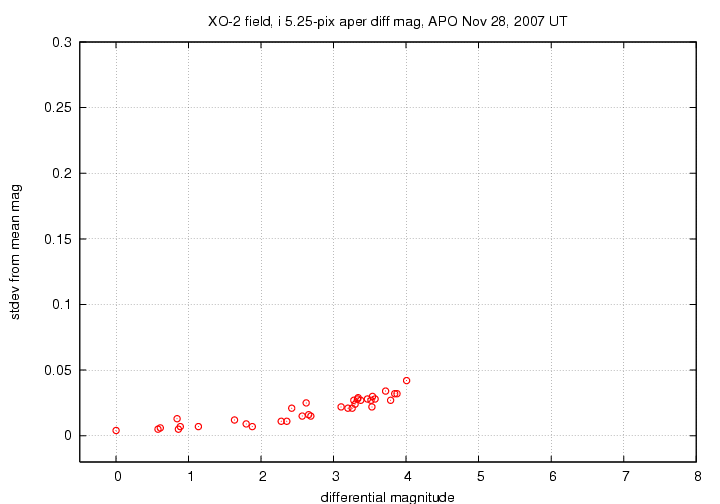
On the night of UT Nov 28, 2007, the SDSS Photometric Telescope ("PT" for short) took a series of exposures of XO-2. We detected ingress and egress under very poor conditions; there is very little to be said about the event.
Notes from the night
This is a chart of the field. XO-2 is the bright star indicated by the crosshairs. The labelled stars will appear in later analysis.

The host star of XO-2 has a magnitude V=11.18 according to XO-2b: Transiting Hot Jupiter in a Metal-rich Common Proper Motion Binary.
Following the procedures outlined by Kent Honeycutt's article on inhomogeneous ensemble photometry, I used all stars available in each image to define a reference frame, and measured each star against this frame. You can find the software package used to do the ensemble photometry online; it's free!
The night was very cloudy. The graph below shows the amount by which instrumental magnitudes from each image needed to be shifted to match the ensemble reference. On a clear night, this graph would show a straight horizontal line.

Below is a graph of the scatter in differential magnitude versus magnitude in the ensemble solution.

XO-2 is the star at differential mag 0.61. The "noise floor" in these measurements is about 0.006 mag -- poor for APO transit work.
Below are the light curves for the target (green symbols) and four comparison stars in the field.

In this closeup, I have shifted the data for two comparison stars to move them closer in magnitude to the target.

The transit in the green symbols is hard to see, perhaps invisible, due to the large scatter and gaps in the measurements. It's really impossible to determine the exact time of egress due to the large scatter at the end of the run.
An ephemeris grabbed from transitsearch.org predicts for this night
----------------------------------------------------------------------------------------
Begin Transit Window PREDICTED CENTRAL TRANSIT End Transit Window
All Times UT
HJD Year M D H M
2454432.82 2007 11 28 7 37 2454432.88 2007 11 28 9 0 2454432.93 2007 11 28 10 23
----------------------------------------------------------------------------------------
The ephemeris ingress of UT 2007 Nov 28 07:37:00 corresponds to JD 2,454,432.817, compared to my rough guess of 432.83(?). The ephemeris egress of UT 2007 Nov 28 10:23:00 corresponds to JD 2,454,432.933, compared to my guess of of 432.93(??). I don't think we really can use these measurements at all.
You can grab the measurements for your own analysis. Below is a table with three flavors of time, plus the differential magnitude of the target and an estimate of the uncertainty in each measurement. I show the first few lines of the file to give you an idea of its format.
# Measurements of XO-2 made with APO PT, Nov 28, 2007 UT. # Each exposure 35 seconds long in SDSS i-band; # Tabulated times are midexposure (FITS header time - half exposure length) # and accurate only to +/- 1 second (??). # 'mag' is a differential magnitude based on ensemble photometry # using a circular aperture of radius 5.25 arcseconds. # # UT day JD-2,450,000 HJD-2,450,000 mag uncert Nov28.77339 4432.77339 4432.77700 0.607 0.006 Nov28.77475 4432.77475 4432.77836 0.606 0.006 Nov28.77615 4432.77615 4432.77976 0.602 0.006
Last modified 12/02/2007 by MWR.